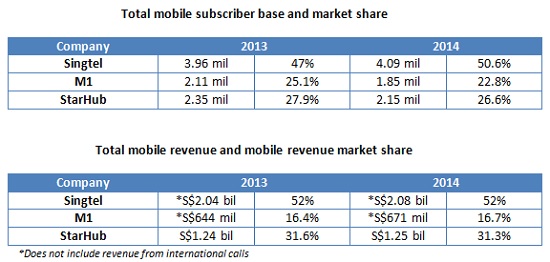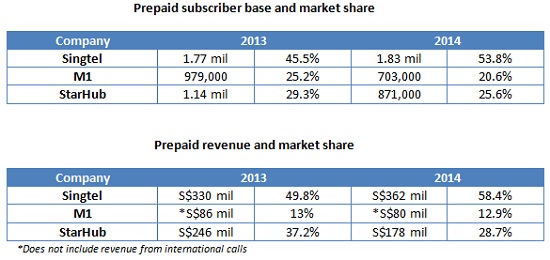Singapore telcos: Winners and losers in 2014
By Goh Thean Eu April 9, 2015
- Singtel continues strong dominance in 2014, no sign of losing momentum
- M1 shows strength in postpaid segment, more improvement needed in prepaid

IN the mobile telecommunications space, it is not easy for one company to stay on top as competitors will do all they can to oust the market leader.
A good example is Malaysia and Maxis Bhd. For many years, it had been the clear market leader, across all segments. Now, although it still is the market leader in the postpaid segment, it has nevertheless lost its position in the prepaid space.
Down south, 2014 was the year Singapore Telecommunications Ltd (Singtel) defended its market leadership across most fronts, and quite well too.
For one, it managed to expand its subscriber base market share from 47% in 2013 to 50% in 2014.
The biggest casualty in terms of subscriber base was M1 Ltd, an associate company of Axiata Group Bhd, which saw its subscriber base market share fall to 22.8%, versus 25.1% in 2013.
Overall, the big three – Singtel, M1 and StarHub Ltd – collectively had 8.09 million subscribers in 2014, representing a 3.91% decline against 2013’s base of 8.42 million.
They however collectively managed to grow total mobile revenue by 2% to S$4 billion (US$2.95 billion). This figure does not include revenue from international calls for Singtel and M1; or their non-mobile businesses such as pay-TV, fixed broadband, and others.
Before Digital News Asia (DNA) dives a bit deeper into how these ‘big three’ telecommunication companies performed in the mobile segment, it is important to note that the information obtained from their respective official websites may only be able to produce a rough idea of how the space has evolved.
We cannot produce an accurate comparison across all sub-segments, as each company discloses its numbers differently.
For example, Singtel announces its overall mobile revenue (which excludes revenue from international calls), but does not break it down between prepaid and postpaid.
To obtain those figures, one could take Singtel's average revenue per user (ARPU) and multiply it by the number of subscribers. However, its declared ARPU has factored in revenue from international calls. [Note: This means you will get some discrepancies if you tally up the market segment figures below to arrive at the total].
Also worth noting is the fact that Singtel’s revenue related performance in 2014 was based on the company’s first three quarters of its 2014/ 2015 financial period ended March 31, 2015, as well as the fourth quarter of its 2013/2014 financial period ended March 31, 2014. This was done so that a comparison can be made based on the 2014 calendar year.
Overall market [S$1 = US$0.74]

In 2014, Singtel appears to have been the only one among the big three which managed to grow its subscriber base, both prepaid and postpaid.
M1 was the biggest loser in terms of subscriber market share, but the market’s second biggest player StarHub was not spared either. Its mobile subscriber base market share fell to 26.6%, against 27.9% in 2013.
In terms of revenue market share, Singtel managed to defend its leadership position by maintaining its 52% slice.
M1, which lost the most subscriber market share, was the only player able to gain mobile revenue market share, from 16.4% in 2013 to 16.7% in 2014. During the year, its revenue jumped 4% to S$671 million, higher than the industry growth of 2%.
Not much change in postpaid

During the year, all three mobile operators grew their subscriber base, led by Singtel with a postpaid subscriber base growth of 3% to 2.26 million, followed by StarHub’s 1.28 million postpaid subscribers and M1’s 1.15 million.
While the race for the second spot in postpaid subscribers seemed close, it wasn’t the case for postpaid revenue.
In 2014, Singtel captured the giant’s share with S$2.02 billion, followed by StarHub with S$1.06 billion and M1 with S$591 million.
As far as market share is concerned, the postpaid segment is probably the only area where Singtel showed a decline in 2014. Its postpaid subscriber market share fell marginally to 48.2% (versus 48.3% in 2013), while its postpaid revenue market share dipped to 55% (versus 56.1% in 2013).
Big win for Singtel in prepaid

If there is one segment that Singtel showed clear dominance in 2014, it would be in prepaid, having grown its prepaid subscriber base by 5.7% to 1.83 million.
M1 and StarHub struggled to grow their subscriber base and revenue. M1’s prepaid subscriber base fell by 28% to 703,000, while StarHub’s subscriber base declined by 23.6% to 871,000.
In terms of prepaid revenue, StarHub suffered a 27.6% decline to S$178 million while M1 dipped 7% to S$80 million. Singtel registered a 9.7% improvement to S$362 million.
Singtel’s strong performance in the prepaid segment also expanded its market share from 49.8% in 2013 to 58.4% in 2014.
Investments in 2014 and plans for 2015
In terms of capital expenditure (capex), M1 appears to have been the ‘biggest spender’ in 2014 if measured based on percentage of operating revenue.
It spent S$180 million in 2014, or close to 17% of the group’s S$1.07 billion operating revenue. It is expected to spend some S$120 million in 2015.
StarHub spent S$322 million on capex (or 14% of the group’s operating revenue) in 2014, and is expected to allocate about 13% of group operating revenue as capex in 2015.
Singtel, which has been consistently spending over 11% of its operating expenditure as capex over the past few years, is expected to allocate a similar ratio for 2015.
While the companies did not go into details of how each and every dollar will be spent, it would not be surprising to see a substantial portion go into improving data/ mobile broadband services, as consumers are spending more time using their smartphones to access the Internet.
In fact, M1 reported that data usage of smartphone users contributed 65% of total data traffic in 2014, up from 55% in 2013. Also, the average data usage grew to 3GB a month in the fourth quarter 2014, from the monthly usage of 2.5GB a year ago.
Conclusion
While it is likely there will be no changes in the overall plot – with Singtel continuing to be the No 1 mobile player in Singapore, followed by StarHub and M1 – there could be some interesting subplots, depending on how each telco reacts.
Although Singtel remained dominant in all areas, how will it react to its ‘minor loss’ in postpaid revenue and subscriber market share? How will M1 and StarHub compete in the postpaid segment?
More importantly, will StarHub and M1 see a rebound in the prepaid segment? Or will Singtel continue to expand its lead in this area?
Only time will tell.
Related Stories:
Slugfest: Malaysia’s Big 3 mobile operators’ FY2014 performance
Singtel aims to be among first to roll out 5G in 2020
A deeper look into Malaysia’s Big 3 mobile telcos in 1H2014
For more technology news and the latest updates, follow us on Twitter, LinkedIn or Like us on Facebook.


